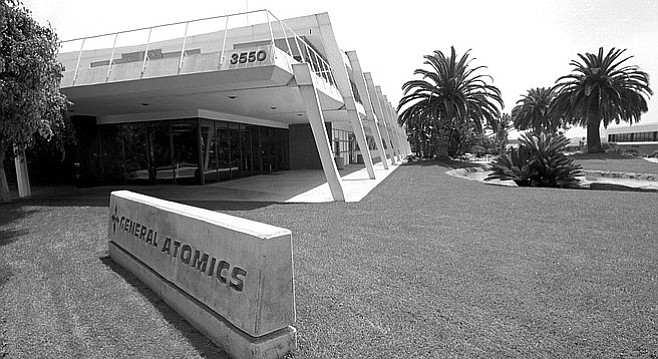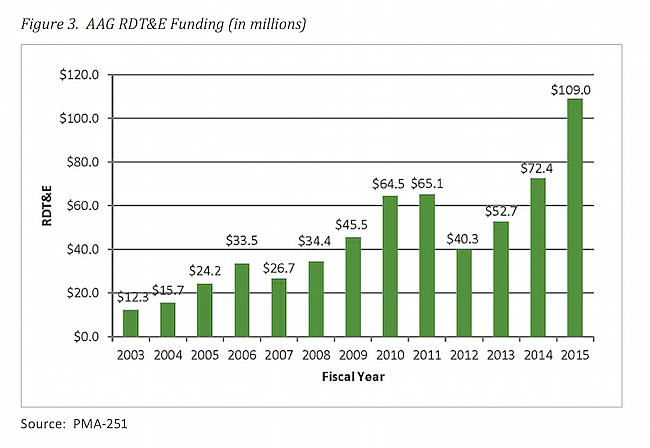 Facebook
Facebook
 X
X
 Instagram
Instagram
 TikTok
TikTok
 Youtube
Youtube

General Atomics, a pillar of San Diego's lucrative military contractor economy and the source of millions of dollars in campaign contributions to federal, state, and local officeholders of both parties, has a nine-figure lemon on its hands.
So says a newly released Pentagon audit of the Navy's so-called Advanced Arresting Gear project, a costly bid to replace the traditional cables used to stop fighter jets after landings on aircraft carriers

According to General Atomics, the design of the new high-tech system “uses simple, proven energy-absorbing water turbines coupled to a large induction motor for fine control of the arresting forces."
Well, actually not so simple, and definitely not proven, says the July 5 audit from the Inspector General's office of the Department of Defense.
"Ten years after the program entered the engineering and manufacturing development phase, the Navy has not been able to prove the capability or safety of the system to the level that would permit actual testing of the system on an aircraft carrier because of hardware failures and software challenges," says the audit.
"This occurred because the Navy pursued a technological solution for its Ford-class carriers that was not sufficiently mature for the planned use, resulting in hardware failures to mechanical and electrical components and software modifications to accommodate those failures."
The bottom line for taxpayers is equally dismal.

"As of October 2015," the document says, "[Research, Development, Test and Evaluation] costs for the program total $743.5 million, which was $571.5 million above the planned costs in the 2005 Acquisition Program Baseline."
Further project delays are in store, with costs through 2020 and beyond currently projected to hit over $916 million.
"Development testing originally scheduled to end in FY 2009 will continue through FY 2018, and reliability of the system is uncertain."
Expenses are growing so quickly that the report says the Navy "should perform cost-benefit analyses to determine whether the Advanced Arresting Gear is an affordable solution for Navy aircraft carriers before deciding to go forward with the system on future aircraft carriers."
The audit blames the Navy for insufficient policing of project contractor General Atomics.
"Specifically, the Program Manager, Aircraft Launch and Recovery Equipment, did not effectively manage the acquisition to meet requirements,” according to the document. "Furthermore, aircraft compatibility testing may uncover additional challenges with the arrestment of other carrier-based aircraft, requiring further redesign and software rework."
The Senate Armed Services committee is also taking a stern look into the matter. "The committee believes the Navy must pause and reconsider the way ahead, including the best business case, for the arresting gear on CVN-79 (Kennedy) and CVN-80 (Enterprise) and notes the Navy has already begun such a review,” says a June committee report.
La Jolla–based General Atomics has done multi-billions of dollars of work for the U.S. Department of Defense and Central Intelligence Agency, including production of its most famous weapon, the Predator drone.

Co-owned by San Diego's billionaire Blue brothers, Linden and Neal, the company is a big political giver and major political player in its own right, with employees coming up with $14,500 for the GOP Lincoln Club, noted for its take-no-prisoners hit pieces against Qualcomm-favored mayoral hopeful Nathan Fletcher and $10,325 for Republican mayor Kevin Faulconer's 2016 reelection campaign.
Though largely givers to Republican causes, the brothers have also favored powerful, pro-military Democrats, including California senator Dianne Feinstein, who got $54,750 from General Atomics–sourced funds in 2012. The same year, San Diego GOP congressman Duncan Hunter picked up $16,450, according to campaign disclosure data from OpenSecrets.org.
Besides their military work, the brothers operate a controversial uranium mining and processing operation heavily dependent on government clean-up permits.
Five years ago, Linden Blue authored a blistering critique of Europe's welfare state and Democratic president Barack Obama.
"It is instructive that President Obama employs the European model of entitlement, regulation and income redistribution as his guide," said the commentary, co-written by Herbert London, President Emeritus of Hudson Institute and Professor Emeritus of New York University.
"As the U.S. borrows more than 40 percent of the federal budget this year, we are perilously close to emulating the worst of Europe."


General Atomics, a pillar of San Diego's lucrative military contractor economy and the source of millions of dollars in campaign contributions to federal, state, and local officeholders of both parties, has a nine-figure lemon on its hands.
So says a newly released Pentagon audit of the Navy's so-called Advanced Arresting Gear project, a costly bid to replace the traditional cables used to stop fighter jets after landings on aircraft carriers

According to General Atomics, the design of the new high-tech system “uses simple, proven energy-absorbing water turbines coupled to a large induction motor for fine control of the arresting forces."
Well, actually not so simple, and definitely not proven, says the July 5 audit from the Inspector General's office of the Department of Defense.
"Ten years after the program entered the engineering and manufacturing development phase, the Navy has not been able to prove the capability or safety of the system to the level that would permit actual testing of the system on an aircraft carrier because of hardware failures and software challenges," says the audit.
"This occurred because the Navy pursued a technological solution for its Ford-class carriers that was not sufficiently mature for the planned use, resulting in hardware failures to mechanical and electrical components and software modifications to accommodate those failures."
The bottom line for taxpayers is equally dismal.

"As of October 2015," the document says, "[Research, Development, Test and Evaluation] costs for the program total $743.5 million, which was $571.5 million above the planned costs in the 2005 Acquisition Program Baseline."
Further project delays are in store, with costs through 2020 and beyond currently projected to hit over $916 million.
"Development testing originally scheduled to end in FY 2009 will continue through FY 2018, and reliability of the system is uncertain."
Expenses are growing so quickly that the report says the Navy "should perform cost-benefit analyses to determine whether the Advanced Arresting Gear is an affordable solution for Navy aircraft carriers before deciding to go forward with the system on future aircraft carriers."
The audit blames the Navy for insufficient policing of project contractor General Atomics.
"Specifically, the Program Manager, Aircraft Launch and Recovery Equipment, did not effectively manage the acquisition to meet requirements,” according to the document. "Furthermore, aircraft compatibility testing may uncover additional challenges with the arrestment of other carrier-based aircraft, requiring further redesign and software rework."
The Senate Armed Services committee is also taking a stern look into the matter. "The committee believes the Navy must pause and reconsider the way ahead, including the best business case, for the arresting gear on CVN-79 (Kennedy) and CVN-80 (Enterprise) and notes the Navy has already begun such a review,” says a June committee report.
La Jolla–based General Atomics has done multi-billions of dollars of work for the U.S. Department of Defense and Central Intelligence Agency, including production of its most famous weapon, the Predator drone.

Co-owned by San Diego's billionaire Blue brothers, Linden and Neal, the company is a big political giver and major political player in its own right, with employees coming up with $14,500 for the GOP Lincoln Club, noted for its take-no-prisoners hit pieces against Qualcomm-favored mayoral hopeful Nathan Fletcher and $10,325 for Republican mayor Kevin Faulconer's 2016 reelection campaign.
Though largely givers to Republican causes, the brothers have also favored powerful, pro-military Democrats, including California senator Dianne Feinstein, who got $54,750 from General Atomics–sourced funds in 2012. The same year, San Diego GOP congressman Duncan Hunter picked up $16,450, according to campaign disclosure data from OpenSecrets.org.
Besides their military work, the brothers operate a controversial uranium mining and processing operation heavily dependent on government clean-up permits.
Five years ago, Linden Blue authored a blistering critique of Europe's welfare state and Democratic president Barack Obama.
"It is instructive that President Obama employs the European model of entitlement, regulation and income redistribution as his guide," said the commentary, co-written by Herbert London, President Emeritus of Hudson Institute and Professor Emeritus of New York University.
"As the U.S. borrows more than 40 percent of the federal budget this year, we are perilously close to emulating the worst of Europe."
Comments